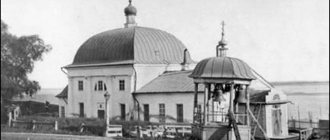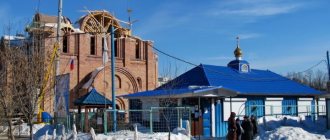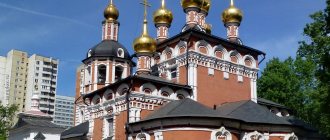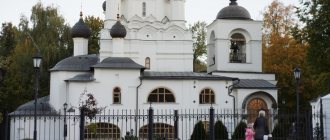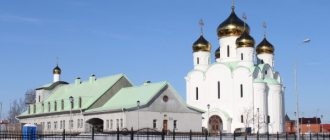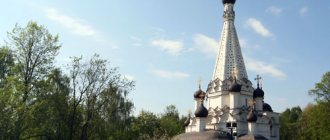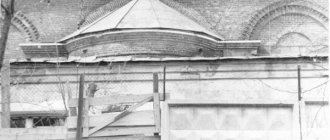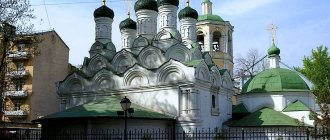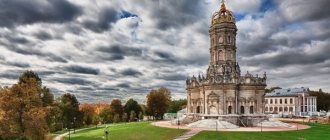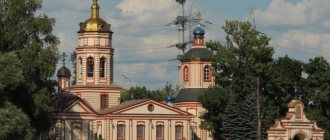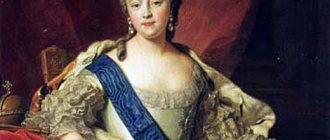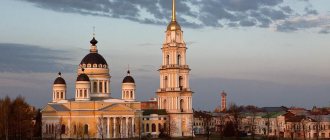The Church of the Intercession of the Blessed Virgin Mary on Silver Island in the Izmailovo district, the town named after Bauman, Moscow, Russia, is an Orthodox church of the Nativity deanery of the Moscow city diocese. Today it is an architectural monument of Russian architecture of the 17th century. - an object of cultural heritage of Russia and is protected by the state.
Having been plundered several times and having gone through difficult times, the cathedral is gradually being restored and has long opened its doors to pilgrims, believers and ordinary tourists.
Church of the Intercession of the Blessed Virgin Mary in Izmailovo today
The temple is located next to the former royal residence. The image of the Mother of God is one of the most beloved among the people and is especially revered in Russian Orthodoxy. The Protector Mother of God more than once saved the country both from disease and from the invasion of enemies. It was in her honor that this temple was erected, as a thank you to her patronage.
It is believed that the glory of Russian weapons has thundered throughout the world more than once thanks to the protection of the Mother of God.
Church of the Intercession of the Blessed Virgin Mary from a bird's eye view.
The temple is a grandiose structure with a five-tiered iconostasis, which once had a very high status. The cathedral was badly damaged during the invasion of Napoleon and the reign of Soviet power and requires further restoration.
Miracles created by the icon
The Izmailovo Jerusalem Icon became especially famous for its healings during the terrible plague epidemic in Moscow in 1771. After this, she began to be revered as miraculous. And in September 1866, she helped stop the cholera epidemic that was approaching Moscow from the south.
Residents of the southern outskirts of Moscow asked to release this icon to them to perform prayer services and offer a common prayer in front of it. In a special ark in their hands, the miraculous image was carried with a religious procession from Izmailovo through Kolomenskoye, Nagatino, Novinki and Dyakovo, where prayer services were incessantly performed before it, after which the epidemic stopped.
Moreover, in the village of Dyakovo near Kolomenskoye, on the day of the shrine’s presence, a seven-year-old peasant girl from a family of Old Believers was miraculously healed of blindness; her mother, secretly from her relatives, brought her to venerate the Orthodox miraculous icon and she herself fervently prayed in front of it. Tears appeared in the girl’s eyes, and then she began to see clearly. After this, many Old Believers bowed to the icon, promising to return to the Orthodox Church.
The patronal feast of the Izmailov Cathedral falls in the autumn, which was considered the best time for weddings. In the fall, princesses always came here and prayed for a happy marriage. According to an old belief, such a maiden prayer will be heard by the Most Holy Theotokos if the petitioner offers it in the Church of the Intercession and places a candle in front of the temple image.
History of foundation, construction
The village of Izmailovo is a royal estate, mentioned in the chronicles of the 16th century. Since then, a large number of drawings of buildings and the layout of the settlement have been preserved; there is an opinion that this is one of the first complexes of Tsarist Russia, where everything was built according to them. The sovereign's courtyard, numerous buildings and a huge farm were characteristic of Izmailovo at that time, where about 4 thousand peasants lived and worked.
Here were:
- gardens and greenhouses with exotic plants; mulberry trees were grown here;
- barnyard and mill;
- pharmacy chamber;
- Glass factory;
- menagerie.
Not a single settlement could exist without a church or chapel, especially a royal residence. In honor of the victory of 1619, when the Polish king Vladislav tried to take the Russian throne, a wooden temple was erected in Izmailovo. Since the event took place on the Feast of the Intercession, it was given the name Pokrovsky.
Izmailovo became the favorite royal residence, so the sovereign gave the order to erect a stone cathedral here, which was built on the model of the temple located in Aleksandrovskaya Sloboda. It was conceived as a front door, where all festive services would be performed, including by the patriarch.
The temple amazed with its size and luxurious decoration; its 5 domes were the largest in Moscow. The temple was decorated by the best craftsmen from Yaroslavl, Moscow and Kostroma. The cathedral did not have a belfry, so it was organized in a tower connecting the island on which the Izmailovo complex is located with the rest, placing 7 bells and a clock there.
In 1679, in the presence of the royal family, the patriarch consecrated the temple, where since then the highest clergy served on all major holidays.
The beloved royal residence and the main cathedral were badly damaged during Napoleon's invasion. The temple was looted, fires were lit in it, the iconostasis was preserved, but because of the fire, the destruction of the building, vault and domes began. Until 1839, desolation and ruin were here.
Initially, the new cathedral was an exclusively religious building, then civil buildings were added to it. By order of Emperor Nicholas I, it was decided to build an almshouse for soldiers and officers - a shelter for veterans and disabled people of the Patriotic War of 1812.
Architect K.A. Ton is adding multi-story buildings resembling barracks to the Intercession Church on 3 sides, while demolishing 2 wings of the cathedral. By all accounts, this was one of the most unsuccessful ideas of the talented architect, which disfigured the majestic temple.
Nevertheless, restoration began, to which the best masters of St. Petersburg were invited. The restored cathedral was consecrated in 1847, and the almshouse 2 years later. In this form, the complex of buildings performed its functions until the October Revolution.
In those days, numerous commissions visited the cathedral, noting its cultural and religious value, however, the temple was again looted, the iconostasis was destroyed, and only the miraculous Jerusalem icon was transferred to another temple.
After that, the building housed the NKVD archive, and then a vegetable warehouse.
After 20 years, it was decided to open a concert hall in the cathedral, and a new restoration of the temple began.
Instead of an almshouse, there is a workers' town named after. Bauman with the first communal apartments.
The territory of the former royal estate was built up with infrastructure facilities of Soviet Russia.
Only in 1994 were the building and relics returned to the Church. Some of the interiors have been restored, but the iconostasis and interior decoration are still subject to restoration.
After the renovation of the building, the temple returned to operation in 1997; restoration of the interior decoration was largely completed by 2002.
Don’t miss the most popular article in the section: Belgorod Fortress in Belgorod - why it’s unique, historical facts and excursions.
The Intercession Cathedral on Izmailovsky Island was considered the most grandiose building in Moscow
There is a legend that, at the suggestion of boyar Artamon Matveev, the educator of the future wife of Tsar Alexei Mikhailovich, Natalya Kirillovna, the stone Intercession Cathedral on Izmailovsky Island was built in the image of the Assumption Cathedral of the Moscow Kremlin. Whether this is true or not is quite difficult to say today. Only one thing can be said for certain - the temple was built deliberately of enormous size in order to perform festive services in it during the reception of the sovereign's guests.
But there is documentary evidence that the Intercession Cathedral of Alexander Sloboda, the former residence of Tsar Ivan the Terrible, was taken as a model. The contract entry reads: “To make a stone church in the old village of Izmailovo, unlike the model of the cathedral church in Alexandrovskaya Sloboda, without basements, the length between the walls is nine fathoms, the same diameter, and the height of the church and altar as needed, and around that church to make three steps as necessary , and let us do the church stone work as the apprentice instructs.” However, the five-domed cathedral that was built is really more reminiscent of the Kremlin Assumption Cathedral.
Architect, exterior decoration, architectural ensemble
The Church of the Intercession of the Blessed Virgin Mary in Izmailovo was truly a unique structure. The work was supervised by masons from Kostroma Fyodor and Grigory Medvedev and the royal architect Ivan Kuznechik; the structure turned out to be grandiose for those times, with a total height of 57 m.
The foundation of the cathedral is shallow, but the thickness of the masonry reaches 2.5 m. The building is built of brick, 3 naves of the temple are crowned by 5 domes, the diameter of the central one reaches 8.5 m, the rest - up to 7 m.
The vertical architectural framing of the windows and facade had no analogues in those days. To make the cathedral light and slender, a special technique was used: elongated half-columns, which also decorate the skylights of the cathedral. The semi-columns are connected to each other by small arches and decorated with kokoshniks.
The building was given grandeur by 3 adjacent porches with 11 steps; today only 1 porch has survived. It gave the impression of a mansion resting on white stone carved pillars and arched passages.
Rich platbands and tiles with gold and green glaze decorate the drums and façade. Stylized patterns in the form of flowers and feathers, the so-called “peacock eye” by the master from Belarus Polubes S., run at the level of the vaults, decorating the cathedral. Brick walls, white stone decorations, bright tiles in blue, yellow and green colors create a special flavor and are reminiscent of Russian architecture of the 17th century.
History[edit]
At the turn of the 15th–16th centuries, a wooden church stood on the site of the Intercession Church. It was probably burned during the invasion of the Crimean Khan Devlet Giray. The new wooden three-tent temple was built by the boyar Nikita Ivanovich Romanov in the late 1610s - early 1620s.
The stone Church of the Intercession was built for the royal estate of Izmailovo under Tsars Alexei Mikhailovich and Fyodor Alekseevich. Consecrated in 1679 by Patriarch Joachim in the presence of Tsar Feodor. The three-nave monumental structure made of brick with individual white stone details is crowned with five chapters, the diameter of the central chapter is 8.5 m. The outside of the temple is decorated with outstanding multi-colored tiles (master Stepan Polubes, the “peacock eye” pattern, as well as various floral patterns). The inside of the temple has four pillars; the original interior has been lost.
After 1812 (when the temple was badly damaged by the invasion of the French, who burned bonfires in it), an almshouse for disabled people from the Patriotic War (later also other wars of the 19th century; now the Bauman Town, architect Konstantin Ton) grew up around the temple. When the almshouse was added to the walls of the cathedral, the porches adjacent to the church on the north and south sides were dismantled. In the 1840s, the iconostasis was restored. In 1854-1922, the Izmailovo list of the Jerusalem icon was kept in the Church of the Intercession (now in the Izmailovo Church of the Nativity, and in the Church of the Intercession there is a list).
During Soviet times, the church was closed along with the almshouse (since 1918); in 1928, the NKVD archive, the most valuable icons preserved from the 17th century, were housed in it. The five-tiered iconostasis disappeared. Then a fruit warehouse was placed in the temple, the iconostasis structures were destroyed, and large icons went to fruit shelves (in the 1960s, the icons that served as shelves were given to the Andrei Rublev Museum of Ancient Russian Art). In 1970-1980, the cathedral was a warehouse for the Informelektro Research Institute, then the interiors began to be reconstructed into a concert hall.
The temple has been operating again since the 1990s, and the few surviving icons have been returned to it. In 2001-2002, a new iconostasis was created.
Interior decoration
The interior decoration of the Church of the Intercession of the Blessed Virgin Mary in Izmailovo was quite traditional, and at the same time, one of the best in Moscow:
- the vaults of the cathedral were supported by 4 powerful pillars;
- wall painting;
- painted place for the patriarch;
- choirs for the royal family, which testified to the high status of the cathedral;
- the floors were made of valuable wood;
- 40 painted windows, richly decorated with cloth;
- the forever lost 18-meter iconostasis, silver-plated and painted with floral patterns, was made by the best craftsmen of the Armory Chamber. More than 100 artists worked on the icons, the size of which reached 5 m in height. Fyodor Zubov, who created the image of the 12 apostles in the Kremlin, painted the image of the Intercession of the Mother of God for the Intercession Cathedral.
In the 90s The cathedral was returned to the Russian Orthodox Church. Today, leading architects are working to recreate its former grandeur and historical appearance. The painting work is supervised by the artist Nuzhny N., who has already painted 109 images recreating the icons of 1678. All restoration work is also carried out at the expense of benefactors, among whom are the descendants of the Romanovs.
Sample that was copied
In January 1676, in the midst of work, Alexei Mikhailovich died suddenly, and Tsar Fyodor Alekseevich finally embodied his father’s plan. He ordered the cathedral to be made even more majestic and richly decorated. The Intercession Cathedral became famous for its size. Its five powerful onion-shaped domes are considered the largest domes in Moscow.
At one time, this cathedral was called one of the most grandiose buildings in Russia at that time. Its height is 57 meters, the central chapter is 18 meters high, which can only be compared with a modern six-story building. Subsequently, the cathedral became a model that was copied in other Russian cities.
However, subsequent measurements and analysis of the cathedral's architecture showed that the builders did not fulfill the wishes of the customer and the structure was not analogous to the temple in Aleksandrovskaya Sloboda. But at the same time, it can safely be called unique and unusually beautiful.
On October 1, 1679, on the eve of the Feast of the Intercession, Patriarch Joachim solemnly consecrated the cathedral in the presence of Tsar Fyodor Alekseevich. From then on, it became customary that on the temple holiday it was the patriarch who had to perform the service. According to legend, sometimes St. Demetrius of Rostov also performed divine services.
Shrines and relics
The Church of the Intercession of the Blessed Virgin Mary in Izmailovo withstood the most difficult times. The main shrine is the Jerusalem Icon of the Mother of God. It was miraculously preserved; it is believed that this icon is a copy of the image painted by the Apostle Luke.
It was presented by the Byzantines to Prince Vladimir during the capture of Kherson and after his baptism in 988. Later transferred to the Kremlin from Novgorod, from there in the 17th century. They made a list for the temple in Izmailovo, but the original was lost forever after the invasion of Napoleon.
The image is considered miraculous; according to legend, the icon stopped the spread of the plague in Moscow in 1771, and then cholera 100 years later, and also returned the Old Believers community to Orthodoxy, healing a girl from blindness.
The church especially honors the martyrs who suffered for the Christian faith: Prince Chernigov and his faithful comrade-in-arms Fyodor died in the Golden Horde, refusing to bow to the idols of Batu.
Also in the temple there are already restored icons patronizing the house of the Romanovs:
- Mother of God of Vladimir;
- image of St. Nicholas the Wonderworker;
- images of St. George the Victorious and Dmitry of Thessalonica, located in the southwestern part of the temple;
- in the southeast you can find icons of Saints Daniel of Moscow and Dmitry Donskoy.
In 2009, the temple was given a copy of the miraculous icon of the Feodorovskaya Mother of God, made in the art workshop of Nizhny N. This image is especially revered by the descendants of the Romanovs, since before him Mikhail Fedorovich was blessed to the kingdom. In honor of the Mother of God of Feodorovskaya, the patronymic was given to foreign brides of the royal heirs when baptized into Orthodoxy.
There is also an ark with the relics of saints here:
- Reverend Elders of Optina;
- Great Martyrs: Akakios of Athos, Bishop Harlampius, Panteleimon the Healer, Theodore Tiron.
Shrines
There is always a crowd around the holy image of the Mother of God “Jerusalem”, which has miraculous power that grants healing. Parishioners also worship near the temple icon of the Intercession of the Mother of God.
Miraculous Icon of the Mother of God of Jerusalem
Prayer books are attracted to Arks containing the relics of saints, including:
- Rev. Isaac the First;
- Reverend Optina Elders;
- Rev. Anatoly Potapov;
- martyr Akakios of Athonite;
- Great Martyr Panteleimon;
- Great Martyr Theodore Tiron and others.
The Izmailovo shrine also preserves parts of the Mamvrian oak.
Clergy, mentors
In addition to religious services, the clergy of the temple carries out a great deal of work to provide various assistance to those in need, and also, with the help of trustees, organizes restoration work here.
| Temple Clergy and Mentors | |
| Temple rector | Archpriest Vladimir Bushuev |
| Trustees | Charitable Foundation "Anastasios" |
| descendants of the Romanov family | |
| Perform services | Priest V.P. Kazantsev |
| Priest D.A. Makeev | |
| Archpriest P.F. Ilkevich | |
The Emperor made a royal gift
The 19th century turned out to be unlucky for Izmailovsky Island. In 1812, Izmailovo was captured by Napoleon. His hordes plundered and desecrated the Intercession Cathedral. The French lit fires to warm themselves from the autumn cold. The iconostasis of the cathedral was preserved, but the fire cracked the cathedral vault and tilted the main dome. Divine services stopped and the cathedral was not restored for a long time. And the island itself stood in complete desolation for almost three decades.
Gradually, in the place where there was once an orchard and greenhouses, a dense thicket grew. All that was left of all the luxury were fragments of foundations, oak piles, fragments of tiles and glassware.
In 1837, the 25th anniversary of the Patriotic War was celebrated. Emperor Nicholas I came to Moscow for the celebrations. He visited Izmailovo and made a truly royal anniversary gift to the heroes of 1812 - he gave his ancestral property as a military almshouse for disabled veterans of the Patriotic War.
According to the charter, retired officers and lower cadet ranks who were injured in the war, sick or old, who for these reasons were not able to “earn their livelihood through labor,” were accepted into it for charity.
Here the heroes of Borodin and Tarutin, Maloyaroslavets, Krasny, and the capture of Paris were supposed to find shelter and medical care, but then disabled people from the Crimean, Turkish and other wars were added to them. The almshouse itself received the name of its founder and began to be called Nikolaevskaya.
Social work, everyday life
The church constantly carries out social work in various areas:
- Support for boarding house for labor veterans No. 19 in Moscow. In the wooden chapel at the boarding house, services and prayers, readings of the lives of saints and explanatory conversations are held. The sacraments are performed and assistance is provided for the everyday needs of the residents.
- Assistance is provided to parishioners if necessary, including psychological assistance; a certified specialist works at the church.
- Things are regularly collected and distributed to those in need.
Ton's project was not the most successful
The sovereign commissioned his favorite architect Konstantin Ton to build it, who won the design competition for the Cathedral of Christ the Savior, also built in memory of the heroes of the Patriotic War. However, unlike this temple, the construction of the Nikolaev almshouse was considered a failure by everyone.
The fact is that Thon built multi-storey buildings close to the cathedral on three sides and at the same time demolished two beautiful temple porches. In addition, he connected the southern and northern walls of the cathedral with internal gates to the buildings of the almshouse, thus allowing bedridden invalids to listen to the service in the temple with the doors open. Thanks to these ridiculous extensions, the Intercession Cathedral was disfigured and turned into the house church of the St. Nicholas almshouse.
The only thing that gave me any consolation was the competent restoration carried out inside the temple. It was made by invited painters of the St. Petersburg Imperial Academy of Arts, and the work was headed by a friend of the artist Vasily Tropinin, Alexander Yastrebilov. Moscow also owes him the creation of the famous Moscow School of Painting, Sculpture and Architecture, which grew out of the “natural class” of artists founded by him in 1832.
Sunday School
There is a Sunday school at the Church of the Intercession of the Blessed Virgin Mary, open to everyone: schoolchildren, youth and adults.
The following classes are held here:
- temple studies;
- Old and New Testament;
- church singing;
- study of the iconostasis;
- Church Slavonic language and literacy;
- history of the Christian church;
- Orthodox catechism.
Anyone could visit Izmailovo
The restored Intercession Cathedral was consecrated again in 1847. Due to the presence of Emperor Nicholas I and Grand Duke Alexander Nikolaevich at the consecration of the Nicholas Almshouse, another date is often given - 1849. The status of the almshouse was emphasized by the fact that the royal ceremonial chambers were set up in it in case the sovereign or members of his family wished to visit those in need.
At the same time, everyone visited Izmailovo. Many historians visited here, including Alexander Malinovsky, Ivan Zabelin and Ivan Snegirev and others. The French writer Alexander Dumas came to Izmailovo to see the place where Peter I found the legendary boat, and Ivan Bunin was especially delighted with the church of St. Joasaph, which had only a few years to live ...
Patronal holidays
The Patronal Feasts of the Church of the Intercession of the Most Holy Theotokos, that is, the days when the saint in whose honor the cathedral was consecrated are commemorated, include:
- The Protection of the Blessed Virgin Mary, considered one of the most significant in Orthodoxy, is celebrated on October 14;
- transfer of the relics of Mikhail Chernigovsky and boyar Fyodor - October 3 and February 27.
Izmailovsky Island photo
The restored walls of the Sovereign's courtyard fence with economic and administrative buildings lead us to the Front Gate of the Sovereign's Courtyard.
The Estate has preserved architectural monuments of the 17th - 19th centuries, which can now be seen on the territory of Izmailovsky Island.
The front gate is the main entrance to the territory of the Sovereign's courtyard. Built by order of Tsar Fyodor Alekseevich in 1682.
Where is it located, what is in the surrounding area, how to get there
The Church of the Intercession of the Blessed Virgin Mary and the estate in Izmailovo are located in Moscow, at the address: Serebryany Island, Bauman town, no. 1. It is easy to get there by metro, the nearest stations are “Partizanskaya” and “Izmailovskaya”. From there you can walk across the bridge to the town named after. Bauman and visit the temple, if desired, a service.
Buses No. 7 and 131 also run from the metro, but walking will not be tiring, since the main road goes through the park, where you can relax and admire nature.
Restoration and return to Orthodoxy
In 1980, the Moscow authorities decided to open a large concert hall in the beautiful location of Izmailovo, having restored the Church of the Intercession of the Virgin Mary for this purpose.
The year 1991 was a turning point in the return of the shrine under the protection of the Orthodox Church. The historical society “Young Russia” registered the Orthodox community of the Intercession Church, and in 1994, the return of the building itself.
The surviving domes, covered with black scales, like a guiding star, attract the eyes of parishioners and pilgrims who come to worship the Jerusalem holy face of the Mother of God, which is famous for its miracles far beyond the borders of Moscow.
Domes of the Intercession Cathedral
Iconostases in need of restoration were returned from the Spaso-Andronikov Monastery. Gradually, the Church of the Intercession of the Holy Virgin comes to life, acquiring its own traditions. So, Russian holidays are celebrated here every year:
- Navy veterans are invited to Peter the Great’s birthday and memorial services are held;
- Magnificent celebrations were held here in honor of the 310th anniversary of the creation of the Russian navy by Peter the Great.
On the agenda of Moscow architects is the restoration of the Church of St. Joasaph, the arched bridge and the royal estate in Izmailovo. The Anastasios charitable foundation is engaged in the restoration of the Church of the Intercession; accounts have been opened for donations for the restoration of the Izmailovo shrine.
The windows located on the drums are framed by an elegant arcature belt consisting of arched semi-columns. Five keel-shaped kokoshniks became the hallmark of the famous shrine. Thanks to the ceramic decoration, the Intercession Cathedral in Izmailovo looks like an ancient building.
Information for pilgrims
The temple and the former royal residence are open to visitors without restrictions. Since it is active, you need to follow simple rules when visiting the temple. The clothes of men and women should cover their knees and shoulders; traditionally, women cover their heads when entering a temple, even if they go there out of curiosity; men, on the contrary, take off their headdress.
The temple requires further restoration and needs donations, which can be used to purchase traditional candles, books and images of saints. The Jerusalem Icon of the Mother of God, considered miraculous, is located here. In front of her they pray for children and ask for help.
There are no special pilgrimage trips to Izmailovo; you can stay overnight at any hotel in Moscow, for example, there are several on Izmailovskoe Highway within 1 km from the estate, one of them is the Izmailovo hotel complex with beautiful views of the island.
The Church of the Intercession of the Blessed Virgin Mary is an example of ancient Russian architecture. The five-domed, red-stone, tiled cathedral in Izmailovo has gone through a lot in its history. This amazing place of peace and tranquility is hospitably open to everyone, where everyone can find something of their own, ask for help in spiritual and material terms, if necessary.
Author: Elena Gupta
Article design: Oleg Lozinsky
The estate has a long history...
The village of Izmailovo arose in the second half of the 15th century, and began to be called so after the surnames of the Izmailov nobles, the first owners of the estate.
And already in the middle of the 16th century it came into the possession of Nikita Romanovich Zakharyin-Yuryev, who was the brother of Anastasia from the Zakharyin family, who became the queen, the beloved wife of Tsar Ivan IV (Ivan the Terrible) in 1547.
Nikita Romanovich, Anastasia’s brother, was brought closer to the tsar’s court and received the village among other lands granted to him by the sovereign.
The sons of Nikita Romanovich took their surname after their grandfather - the Romanovs. This family, the Romanovs, which later became the royal dynasty, ruled Russia for 300 years, starting in the 17th century.
After the death of Nikita Romanovich, the village of Izmailovo passed to his youngest son, Ivan Nikitich Romanov. He was part of the council of the richest and most respected boyars of the “Seven Boyars” and after the liberation of Moscow from the Poles in 1613 at the Zemsky Sobor, at which the tsar was to be elected, he signed a letter of election to the Moscow throne of Prince Mikhail Fedorovich, his nephew, the eldest son brother Fyodor Nikitich Romanov, who was soon crowned king.
Ivan Nikitich himself settled in Izmailovo. Under him, the wooden Church of the Intercession of the Blessed Virgin Mary was built.
Further development of the estate was carried out by his son Nikita Ivanovich, his heir, who took up the development and arrangement of his estate.
The young Tsar Alexei Mikhailovich Romanov, the next in the Romanov dynasty, who ruled the Moscow kingdom in 1645 - 1676, often came to the family nest, the Izmailovo estate, to hunt and take a break from sovereign affairs. Boyar Nikita Ivanovich Romanov instilled in Tsar Alexei Mikhailovich a passion for falconry.
After the death of his uncle, Nikita Ivanovich, Izmailovo completely passed into the possession of Alexei Mikhailovich. Tsar Alexei Mikhailovich began rebuilding the estate in 1663. He wants to make his favorite places, the ancestral estate of the Romanov boyars, the ceremonial residence of the sovereign, a model estate for his subjects, as well as for foreign guests.
The Grape and Serebryany ponds arose under Alexei Mikhailovich by his decree: in 1667, the Serebryanka River (formerly the Robka River) was divided and blocked with two dams, which turned the site of the former patrimony of the Romanov boyars into a man-made Izmailovsky Island, surrounded on all sides by water.
In the middle of the island was the Sovereign's courtyard. The sovereign's courtyard was fenced off with water in the same way as the Moscow Kremlin in the middle of the city.
Under Alexei Mikhailovich, a large 14-span brick bridge was built across the Silver Pond - this was the main entrance to the island to the royal estate. Through the arch of the Bridge Tower, which ended the bridge, guests got to the Intercession Cathedral.
The bridge tower, built by order of Tsar Alexei Mikhailovich in 1671-74, was made of red brick, three-tiered, and was decorated with valuable tiles symbolizing the Garden of Eden. Tiles covered with blue, white, yellow, and green glaze also decorated the parapets of the brick bridge.
In the lower tier of the Bridge Tower in the 17th century there were rifle guards, and in the upper tier there was a chamber, a clock and a bell tower.
The sovereign village of Izmailovo, outside the island, included vast agricultural lands, greenhouses in which watermelons, melons, walnuts, and dates were grown. In the estate to the north of the island there was a Vine Garden, a mulberry garden, where they tried to grow mulberries.
At the Tsar's courtyard there was a menagerie where moose, deer, bears, sables and even lions, tigers and leopards lived - there were many unexpected and amazing surprises for the guests, there was something to show the guests in the royal estate.
There was an apiary, a small glass factory, where master glassblowers from Venice were invited. There were many flowers everywhere, rare medicinal herbs were grown, there were numerous ponds on the territory, and water pipelines were installed for watering the plants.
The Izmailovo estate, transformed and equipped during the time of Tsar Alexei Mikhailovich, created the impression of a Garden of Eden on earth, which was reflected in architectural creations.
Church of St. Nicholas in Izmailovo (ascribed temple of Danilov stauropegial monastery)
Not far from the Partizanskaya metro station, on the territory of the Kremlin in Izmailovo complex, there is an amazing temple of St. Nicholas the Wonderworker. This very unusual-looking church is made in the ancient traditions of Russian northern architecture. The foundation stone of the temple was completed on September 5, 1997, and the construction was completely completed in 2003. The Church of St. Nicholas in Izmailovo was entirely built of wood, in imitation of ancient examples of religious buildings of ancient Russian wooden architecture. This is the so-called church “like the bells,” the distinctive feature of which is that the ringing tier in it is located above the temple premises itself. Today it is the tallest functioning wooden church in Moscow. The iconostasis of the Church of St. Nicholas was made by icon painters from the village of Mstera, Vladimir region. In the Church of St. Nicholas, services are held on Sundays and other holidays, and the sacraments of Baptism and Wedding are often performed in the temple. But parish life is not limited to just divine services. At the church there is a Sunday school, youth courses in church singing, a school of church floristry, youth, social and catechetical ministries are carried out, and various meetings and conversations are held. Since January 2010, a school of church floristry has been operating at the temple, where classes are held twice a month, on Sundays. The school trains florists to decorate temple icons and the entire interior of the church. The training includes familiarization with the general principles of bouquet design and the basics of composition. Particular attention is paid to wedding floristry, the subject of which is the decoration of weddings and weddings with flowers. Training at the school is conducted by experienced, professional florists according to the author's course. All acquired knowledge and skills can be applied in practice: throughout the year, course participants participate in decorating various temples with flowers. For ten years now, a Sunday school has been operating at the church. The main task of teaching there is to promote the spiritual growth of the child and more fully familiarize him with the content of the Christian faith. The school considers it important that everyone who comes here is immersed in an atmosphere of mutual understanding and love. To keep the younger brothers and sisters of the Sunday school students occupied, several boxes of toys were prepared for them, and for the very little ones, to make their mothers comfortable, there is a changing room. After the service, while the children are studying, parents can drink tea, talk with each other or read a book from the library, or participate in a general conversation with the school’s confessor. Interesting meetings and conversations on current topics are also held for parents. Throughout the year there are festive concerts, quests, intellectual games, excursions, and charity fairs. On Sundays, children in the junior, middle and senior groups study the basics of Orthodox doctrine, the history of the Church, the Church Slavonic language, study in the art studio: sculpt and draw, and also sing in the choir. The acquired knowledge and skills can be immediately put into practice: many children sing in the choir and serve at the altar during divine services. Joint, tent or stationary multi-day camps and pilgrimage trips, which help raise children in faith and friendship, have become a favorite activity for all groups. During trips, the child learns to act in a team, to be responsible and attentive to others. The guys visited the White Sea, Solovki, as well as the Black Sea and Crimea. A trip to Solovki usually takes place at the end of June, when warm weather, the period of white nights, has already begun on the islands. Every time a new route is selected to leave the tent camp, because there are plenty of interesting places on Solovki. The guys go to Crimea during the October holidays, while it is still warm here: cave monasteries, ancient temples, excavations of ancient cities, the sea, mountains and much more await them. You can get acquainted in detail with the life of Sunday school on the temple website. The Church of St. Nicholas has become a real spiritual center of the cultural complex “Kremlin in Izmailovo”. Saint Nicholas has long been revered as the patron saint of sailors, merchants, merchants and artisans. The saint also patronizes the Russian fleet, which also originates from Izmailovo (the “Museum of the Founding of the Russian Fleet” is opened here). On the Serebryano-Vinogradny Pond in Izmailovo, the young Tsarevich Peter mastered the basics of maritime affairs, independently piloting his first boat ship.
